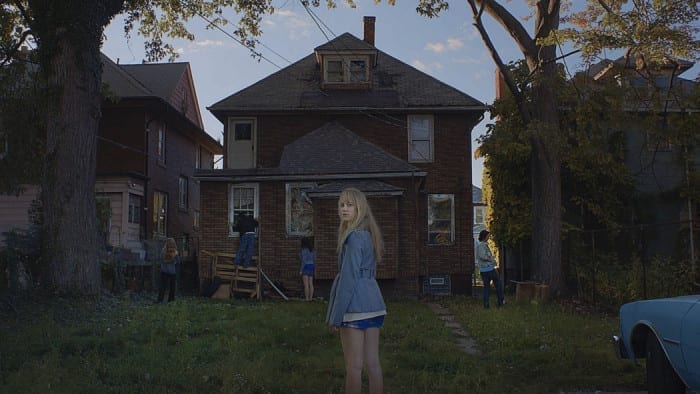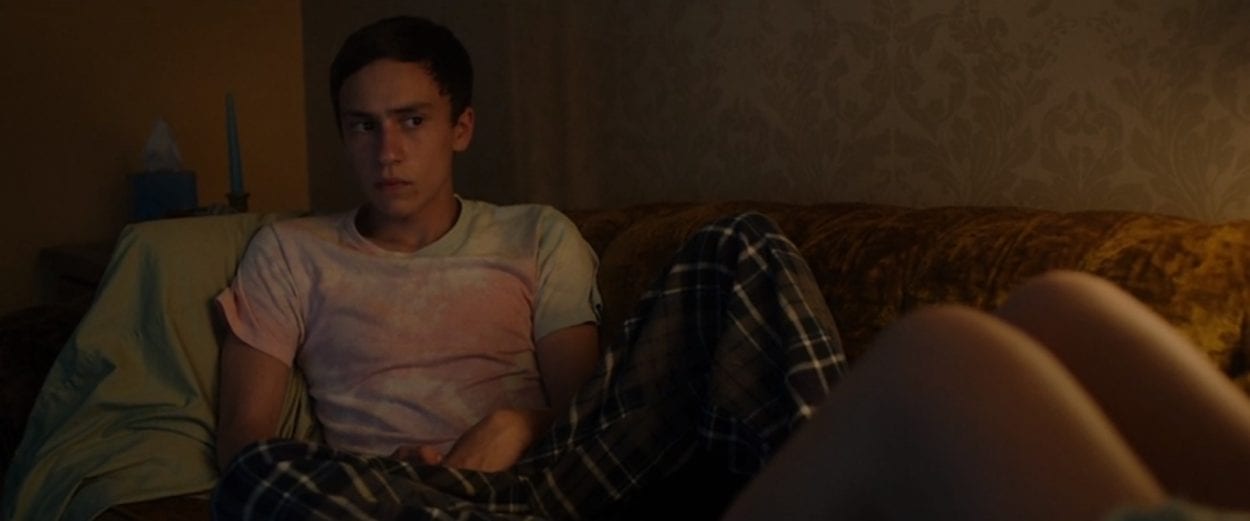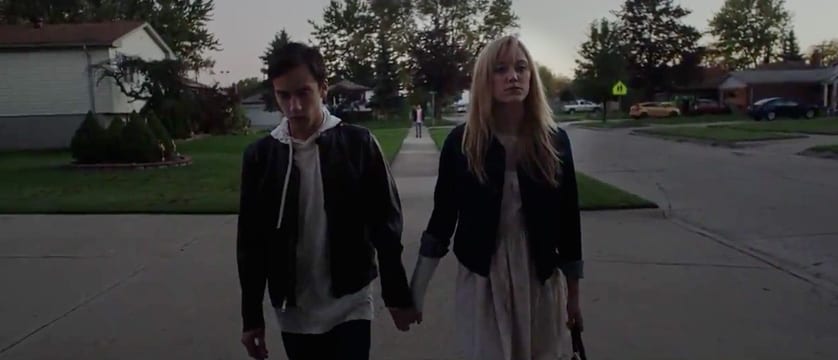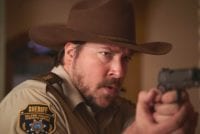It Follows is the 2014 psychological horror from David Robert Mitchell centered around a teenage girl by the name of Jay (Maika Monroe) who finds herself being pursued by a supernatural being after she is lured into a sexual encounter with a stranger. It Follows masquerades as just another supernatural affair on the surface, but it is actually so much more. Jay’s story is as much about her coming of age as it is about an otherworldly force; it is about how she and her friends are entering into the first stages of adulthood. This is a central point of the narrative of It Follows, but as I said, it is so much more.
What we see is a movie that wears its influences on its sleeve. Immediately we are made strikingly aware of John Carpenter‘s influence on Mitchell. The opening scene looks as though it could so easily have been taken right from Carpenter’s horror classic Halloween. The streets that the characters call home look as though they are ripped straight from the iconic Illinois town of Haddonfield. Though one major difference between the two is that the neighborhood from Halloween is a busy, bustling community whereas the suburbs Jay calls home are run-down and filled with empty, dilapidated houses. The way the two differ in this area is also another way they are actually similar.
The setting for Halloween is a time capsule for that era in American history. The nuclear family and the tight-knit community were the two staples of that time. It Follows, on the other hand, was made 6 years ago, in 2014, just after the economic crisis that was brought on by the housing market bottoming out. Unfortunately, we are all too familiar with the ghost estates that were left behind by the droves of people that the crash made homeless.
Many people’s homes were abandoned, seized by the banks, or stopped mid-construction. This abandonment left many neighborhoods with a gaping hole in their communities, which some have never fully filled. Mitchell uses this gap in the community to build a sense of isolation and desolation. Our young protagonists are together, but it feels like they are all alone. We barely see anyone on the streets, and there is hardly a parent in sight. We feel it, that sense of fragility; it follows them just like the creature does. It is everywhere and there is no hiding from it.

What adds to the sense of fragility is how It Follows is shot. The camera work adds so much to the tension of the piece. The way the cinematography is deployed is also reminiscent of the legendary horror Halloween. The action is captured using long tracking shots. The way the camera follows Jay and her friends through the streets of her suburban home is a clear stylistic nod to the classic. Not only are the aesthetics incredibly Carpenteresque, but so is the soundtrack. An excellent synthy score backs the events on screen. Once again, we are reminded of the heavy influential hand John Carpenter had on Mitchell’s style in telling this story.
Another thing in the long list of similarities between the two films is how they induce fear in their audience. The build to the scares is long and the payoff is always worthwhile. Both directors share a sneakiness in how they approach the jump scares in their stories. They are well aware that the anticipation of death is always worse than death itself. Both Carpenter and Mitchell share a talent in how thick they lay that anticipation on. Carpenter is a master at putting you on edge, and Mitchell shows his mastery here, too.
Even when the action is at a lull, your attention is firmly fixed on the background. We are just like the hunted Jay, always on the lookout for “It.” We too fear any approaching stranger, how they could be the cold hand of death, outstretched, just waiting to grab hold of us. Just like Halloween’s legendary antagonist Michael Myers, the “It” is not your chase you down, frothing at the mouth type threat. It is the ever-lingering ominous danger just lurking, waiting for you to let your guard down so it can pounce. Both antagonists are the personification of death, edging ever closer. It doesn’t matter if you can see them or not, they are out there. They are the representation of our own mortality, a reminder that in an instant it can all end.
This sense of impending demise and mortality is another of the themes at the core of It Follows but is joined by another message. That other message is the danger of sexually transmissible diseases, the “It” that follows is passed on through the act of intercourse and remains with the individual for life, like some form of supernatural herpes. When it has passed on it lays dormant but when the creature kills its current target, it comes back to the previous victim. The dormant disease has been reactivated and it quickly targets its old “host.”
Another theme to this extremely layered and well thought out horror is that of innocence lost. Jay and her friends are constantly being nostalgic about the past. They are always swapping stories of when they were young. Their reminiscence gives us the impression that they long for a simpler time. For instance, in the scene where Jay and Paul (Keir Gilchrist) talk about the time they found adult magazines, they are giggling and laughing about the memory. They have temporarily reverted back to a younger state.

Though even with this minute act of regression we are still reminded that too was a moment when they lost a little of their childlike innocence. In that instance, just like the present, they were being ushered towards adulthood at a quicker rate than they were ready for. The events they now face catapult the quickening pace of their youth. Each story they tell is just another reminder that those days are behind them. The days of the safety and security of their youth are in the past and all that lays in front of them is the great unknown.
This theme is just another example of how It Follows uses its subject matter to demonstrate what the experience of entering into adulthood is like. There are many motifs within its narrative but this is the main vein that runs alongside all of the other themes. It is what makes up the majority of the core of this piece, the “It” could be said to be many things. But it is all those things wrapped up in that reoccurring theme: the loss of our past selves and getting to grips with what is left in its place.
Throughout Jay’s struggle with the sexually transmitted creature, we watch as she and her friends try to figure out solutions to this deadly problem. She passes “It” onto Greg (Daniel Zovatto) in hopes that the streetwise ladies’ man will be able to pass “It” on in turn. This ends in the worst possible way for Greg as he is sexually consumed by “It” in the shape of his mother—as I said in the worst possible way. This is another reminder to Jay that she can not just pass the buck, that she will have to take responsibility for what has been thrust upon her.

In the end, Jay finds a compromise for her problems. Instead of passing on the “It” to a hapless stranger or an unprepared friend, she does something else. She shares the load, the old adage that a problem shared is a problem halved. When Jay and Paul sleep together, they decide that they will be united in facing death. This could be said to be an allegory for the act of matrimony in which their coming together is the vow to stay with one another until the end; it is like they say, ’til death do us part.
It is no coincidence that the pair are clad in white at the film’s end. White symbolizes the purity of their unity, just like a bride’s wedding dress. Then you can see that it is accompanied by black attire. The black is a representation of the stain on their innocence, that what they have gone through has left its mark on them indelibly. Even in its final moments, It follows reminds us that the background is not just there for the scenery.
Looking behind Jay and Paul we see “It” there again lingering in the background. “It” is the ever-approaching death that they have decided to face together, no matter what. They are united in their struggle, and this is a powerful message at the end of a harrowing journey. It is an important lesson for us all as humans that when confronted with odds that seem totally insurmountable, it is through each other that we can find the strength to persevere.


